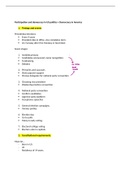Participation and democracy in US politics + Democracy in America
1. Timings and events
Presidential elections
Every 4 years
President dies in office, vice completes term.
On Tuesday after first Monday in November.
Seven stages:
1. Invisible primary
Candidates announced, name recognition.
Fundraising.
Debates
2. Primaries and caucuses
Show popular support
Choose delegates for national party convention
3. Choosing vice president
Weeks/days before convention
4. National party convention
Confirm candidates
Approve party platform
Acceptance speeches
5. General election campaigns.
Various parties.
6. Election day
Go to polls
Many in early voting.
7. Electoral college voting
Electors vote in capitals.
2. Constitutional requirements.
Must be…
- Born in US
- 35
- Residency of 14 years.
,1951: amendment, limit of two terms.
Other elements needed:
a) Political experience
- Eg. State governor/ senator.
- Trump, elected without experience.
- 19 nominated from 1968-2016, 10 served in senate, 6 state governors, 6 VPs.
b) Party endorsement
- Two major parties
- Third parties insignificant.
c) Personal characteristics
- White male
- Changed with H Clinton and Obama.
- Pools of recruitment, dominated with men.
- Married
- Charismatic, lead a movement.
- Speak from heart.
d) Raise money
- Raising a year before election
- H Clinton, raised over $700 million but unsuccessful.
e) Organisation
- Cannot use party structures in process.
- Create organisation.
- Time consuming, expensive, demanding.
- No organisation, fail.
f) Oratorial skills, telegenic
- Look good on TV
- Trump, worked the media, twitter
- ‘I’m too ugly to be president’: Senator Phil Gramm
g) Sound and relevant policies
- Cant be all style no substance
- Practical and relevant policies wanted.
- Trump, thin on policy detail, exception.
3. Invisible primary
Candidates chosen by voters
Little to see in early stages
But candidates gain name recognition and money. Organisation
, High correlation between who is leading in the polls and who wins nomination.
In media. Hope for serious papers and channels.
Components:
a) Candidate announcements
- Early. End of July 2015, 17 declared republicans
- Clinton, announced her running in April 2015
- Supported for candidate demonstrated in opinion polls
- Head to head matches eg. Trump v Cruz
b) TV debates
- 6th August 2015, start of debates. 7 in total.
- 2016, too many democrats, couldn’t fit them on the same platform. Multiple debates
held.
c) Fundraising
- Money raising needs to occur.
- Brings ability to campaign and advertise.
- Trump, come third in terms of money
- Clinton, outraised Saunders by $130 million.
d) Front runners
- Candidates leading normally are confirmed.
- 2016, Trump and Clinton both early front runners. 16 point lead for Clinton, 14 for
Trump
NB: Invisible primaries, most
important for republicans, tend
to nominate front runners.
, 3.Primaries
Primary: electoral contest, determines each parties candidate for the public office.
- Held for all levels of gov.
- Closed primary, only registered party voters vote
- Open primary, cross over voters can vote. No party affiliation.
- Modified primary, independents and registered can vote.
- For presidential races, they are held at state level.
- Voters can cast ballots directly or can pledge support for the convention.
- Show popularity
- Choose delagtes for national convention.
Caucus: Gathering of each parties local activists.
- Layered caucus, local activists select delegates to county meetings. They select
delegates to state meetings
- Smaller states.
- Select delegates for party convention.
- Indicates which candidate is preferred by each state party’s member.
- Democratize nominations
- Lower turnout, physically in a hall.
- Can have second choice if your first doesn’t make 15%
2016
R: held in 10 states
D: held in 14 states
Saunders, strongest, 82% in Alaska.
NB: both under state law.
Timings.
States decide.
National parties lay down earliest/latest dates
Can make regional primaries with neighbour states.
Super Tuesday, 2016, 11 states arranged them together.
More primaries = front loading. Eg. California, moved to early feb in 1008.
Proportional and winner take all primaries
In most, candidates awarded delegates in proportion to votes.
Threshold, normally 15% of vote.
Winner take all, whoever gets most votes gets all delegates at convention.
Eg. Arizona 2016, Trump won all 58 delegates.
Incumbent president.
Little media for presidents parties.
Normally renominated.




